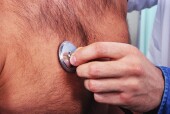Heart Risk Can Be Predicted Without Lab Tests
Finding might help spot high-risk cases in developing countries.
|
E-mail this article
Subscribe to news
Printer friendly version
|

(SOURCE: The Lancet, news release, March 15, 2008)
FRIDAY, March 14 (HealthDay News) -- When it comes to predicting a person's cardiovascular disease risk, cheap, simple and noninvasive methods can be as effective as lab tests, a new study finds.
The U.S. researchers noted these non-lab methods could be especially useful where lab testing is inconvenient or unavailable, such as in developing countries.
Worldwide, about 80 percent of cardiovascular deaths occur in developing nations, Dr. Thomas Gaziano, of the division of cardiovascular medicine at Brigham & Women's Hospital in Boston, said in a prepared statement.
The team analyzed data on 6,186 people who were aged 25 to 74 when they were first examined between 1971-75 for the NHANES I study. At the time, these participants did not report any history of cardiovascular disease -- such as heart attack, heart failure, stroke or angina -- or cancer.
Over a 21-year period, people in this group had 1,529 first-time cardiovascular events, including 578 deaths due to cardiovascular disease.
The researchers compared the lab-based method and the non-lab method in calculating a number called the c-statistic to assess cardiovascular risk prediction. The lab method included age, systolic blood pressure, smoking status, total cholesterol, diabetes status, and current treatment for high blood pressure. The non-lab method substituted body mass index (BMI, a ratio of weight to height) for cholesterol.
The lab and non-lab method gave similar c-statistics, but the non-lab method can provide risk factor information non-invasively and much faster -- just five to 10 minutes, the study authors said. They added that a cholesterol test is too costly for many people in developing countries.
The study was published in the March 15 issue of The Lancet.
"Although this method requires further validation and calibration, use of a simple non-laboratory approach, as suggested by WHO [World Health Organization], could have profound effects on the affordability and availability of an adequate screening program in developing countries," the study authors wrote. "Initial screening without blood testing could lead to the quick initiation of treatment without the added cost or inconvenience of laboratory testing, and would also keep any potential loss to follow-up due to the extra step in testing to a minimum."
However, an accompanying editorial in the journal suggested this approach may not be appropriate for people in developing countries.
"Although tools that use non-laboratory-based variables can help to improve affordability of screening programs for non-communicable diseases, they should not compromise the safety of patients. For equitable care of cardiovascular disease and other major non-communicable diseases, universal access to a set of essential interventions, including laboratory assays, may be required, even in settings with limited resources," wrote Dr. Shanthi Mendis, of the WHO in Geneva, and Dr. V. Mohan, of the Madras Diabetes Research Foundation in India.
More information
The U.S. Centers for Disease Control and Prevention has more about heart disease risk factors.
Copyright © 2008 ScoutNews, LLC. All rights reserved. 
HealthDayNews articles are derived from various sources and do not reflect federal policy. healthfinder.gov does not endorse opinions, products, or services that may appear in news stories. For more information on health topics in the news, visit the healthfinder.gov health library.